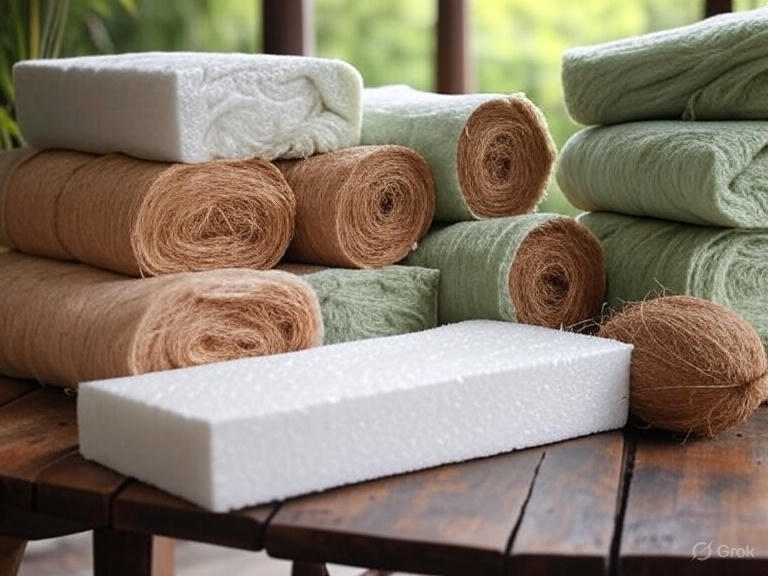
October 01, 2025 - Zed van der Vyver
Introduction to Insulation in Thailand
Insulation is a critical component in Thai homes and buildings, helping manage the tropical climate’s heat, humidity, and heavy rains. It’s not just about keeping warm—it’s about staying cool and dry in a country where temperatures often exceed 35°C. This blog will explain why insulation matters in Thailand, the different types for various needs, how they’re made, and what they might cost. No technical expertise required—just clear info to help you understand this essential feature!
Why Insulation Is Essential in Thailand
Insulation regulates temperature and moisture, key concerns in Thailand’s humid and hot environment. It keeps homes cooler by blocking the intense sunlight common in Bangkok or Phuket, reducing reliance on air conditioning. During monsoons, it prevents condensation and mold growth, a risk in Chiang Mai’s rainy season. It also dampens noise in urban areas and improves energy efficiency, saving costs in the long run. Whether in a rural villa or an urban condo, insulation enhances comfort and protects structures from Thailand’s climate challenges.
Types of Insulation for Different Scenarios in Thailand
Insulation varies by material and application, and the right type depends on your climate and building needs. Here’s a look at common types in Thailand and where they fit best:
Fiberglass Insulation
Use: Walls or ceilings in modern homes.
Why: Made from glass fibers, it’s lightweight and effective at heat resistance, though it needs a vapor barrier in humid areas.
Example Scenario: A condo in Nonthaburi.
Polystyrene Foam Insulation
Use: Exterior walls or roofs.
Why: Rigid and water-resistant, it handles Thailand’s monsoons and provides good thermal insulation.
Example Scenario: A house in Ayutthaya.
Reflective Foil Insulation
Use: Attics or hot climates.
Why: Reflects heat away, ideal for Thailand’s intense sun, and is easy to install under roofs.
Example Scenario: A villa in Phuket.
Coconut Fiber Insulation
Use: Eco-friendly or rural homes.
Why: Made from local coconut husks, it’s sustainable and absorbs moisture, fitting Thailand’s tropical setting.
Example Scenario: A traditional home in Chiang Rai.
Your choice depends on moisture exposure, heat levels, and sustainability goals. Thai brands like SCG or local suppliers offer region-specific options.
How Insulation Is Made in Thailand
Insulation in Thailand is produced to combat heat and humidity while meeting local building needs. Here’s a general overview of the process:
- Material Sourcing: Fiberglass uses recycled glass, polystyrene comes from petroleum, foil is aluminum-based, and coconut fiber is harvested locally.
- Processing: Fiberglass is spun into batts, polystyrene is extruded into boards, foil is laminated onto backing, and coconut fiber is compressed into mats.
- Assembly: Materials are cut to size, with vapor barriers or reflective layers added as needed for Thailand’s wet climate.
- Testing: Insulation is tested for thermal resistance (R-value) and moisture resistance, critical for monsoon readiness.
- Packaging: Products are rolled or stacked, labeled with Thai Industrial Standards (TIS), and distributed.
Factories in Bangkok or Chonburi produce synthetic insulation, while rural areas process coconut fiber using traditional methods.
Cost Comparison of Insulation in Thailand
Insulation costs in Thailand vary by type, thickness, and installation. Here’s a breakdown (in Thai Baht per square meter, as of October 2025):
| Insulation Type | Cost (THB per sqm) | Typical Use | Notes |
|---|---|---|---|
| Fiberglass | 200–500 | Walls/ceilings | Requires installation; vapor barrier adds cost. |
| Polystyrene Foam | 300–800 | Exterior walls | Durable; cutting and fitting increase labor. |
| Reflective Foil | 150–400 | Attics | Easy to install; effective for heat reflection. |
| Coconut Fiber | 100–300 | Rural homes | Low cost; locally sourced material. |
Example Calculation: A 20 sqm fiberglass installation might cost 4,000–10,000 THB, while polystyrene for the same area could be 6,000–16,000 THB. Installation adds 200–600 THB per sqm, higher in cities like Pattaya. Prices are up 10–15% since 2020 due to material costs.
Final Thoughts
Insulation in Thailand keeps your home cool, dry, and energy-efficient, tailored to the tropical climate’s demands. Whether fiberglass for a modern condo or coconut fiber for a rural retreat, there’s a type for every need. Consider your heat and moisture challenges, budget, and sustainability preferences, and consult local suppliers for the best fit. Insulation is a smart investment for comfort. Got questions? Leave a comment—we’re here to help!
